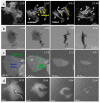Environmental and Health Impacts of Graphene and Other Two-Dimensional Materials: A Graphene Flagship Perspective
- PMID: 38350010
- PMCID: PMC10906101
- DOI: 10.1021/acsnano.3c09699
Environmental and Health Impacts of Graphene and Other Two-Dimensional Materials: A Graphene Flagship Perspective
Abstract
Two-dimensional (2D) materials have attracted tremendous interest ever since the isolation of atomically thin sheets of graphene in 2004 due to the specific and versatile properties of these materials. However, the increasing production and use of 2D materials necessitate a thorough evaluation of the potential impact on human health and the environment. Furthermore, harmonized test protocols are needed with which to assess the safety of 2D materials. The Graphene Flagship project (2013-2023), funded by the European Commission, addressed the identification of the possible hazard of graphene-based materials as well as emerging 2D materials including transition metal dichalcogenides, hexagonal boron nitride, and others. Additionally, so-called green chemistry approaches were explored to achieve the goal of a safe and sustainable production and use of this fascinating family of nanomaterials. The present review provides a compact survey of the findings and the lessons learned in the Graphene Flagship.
Keywords: 2D nanomaterials; biodegradability; carbon materials; environment; exposure; hazard; safe-by-design; test guidelines; toxicity.
Conflict of interest statement
The authors declare no competing financial interest.
Figures





















Similar articles
-
Safety Assessment of Graphene-Based Materials.Small. 2025 Feb;21(7):e2404570. doi: 10.1002/smll.202404570. Epub 2025 Jan 15. Small. 2025. PMID: 39811884 Free PMC article.
-
Assessing and Mitigating the Hazard Potential of Two-Dimensional Materials.ACS Nano. 2018 Jul 24;12(7):6360-6377. doi: 10.1021/acsnano.8b02491. Epub 2018 Jun 18. ACS Nano. 2018. PMID: 29889491 Free PMC article. Review.
-
Two-dimensional nanomaterials: fascinating materials in biomedical field.Sci Bull (Beijing). 2019 Nov 30;64(22):1707-1727. doi: 10.1016/j.scib.2019.09.021. Epub 2019 Sep 20. Sci Bull (Beijing). 2019. PMID: 36659785 Review.
-
Solution-Based Processing of Monodisperse Two-Dimensional Nanomaterials.Acc Chem Res. 2017 Apr 18;50(4):943-951. doi: 10.1021/acs.accounts.6b00643. Epub 2017 Feb 27. Acc Chem Res. 2017. PMID: 28240855
-
The Minderoo-Monaco Commission on Plastics and Human Health.Ann Glob Health. 2023 Mar 21;89(1):23. doi: 10.5334/aogh.4056. eCollection 2023. Ann Glob Health. 2023. PMID: 36969097 Free PMC article. Review.
Cited by
-
Exploring 2D Graphene-Based Nanomaterials for Biomedical Applications: A Theoretical Modeling Perspective.Small Sci. 2025 Mar 16;5(6):2400505. doi: 10.1002/smsc.202400505. eCollection 2025 Jun. Small Sci. 2025. PMID: 40529861 Free PMC article.
-
Biocompatible 2D Material Inks Enabled by Supramolecular Chemistry: From Synthesis to Applications.Acc Chem Res. 2025 Jan 21;58(2):189-198. doi: 10.1021/acs.accounts.4c00596. Epub 2025 Jan 8. Acc Chem Res. 2025. PMID: 39779459 Free PMC article.
-
Assessment of aqueous graphene as a cancer therapeutics delivery system.Sci Rep. 2025 May 2;15(1):15396. doi: 10.1038/s41598-025-98406-0. Sci Rep. 2025. PMID: 40316695 Free PMC article.
-
Microwave radiofrequencies, 5G, 6G, graphene nanomaterials: Technologies used in neurological warfare.Surg Neurol Int. 2024 Nov 29;15:439. doi: 10.25259/SNI_731_2024. eCollection 2024. Surg Neurol Int. 2024. PMID: 39640342 Free PMC article. Review.
-
Safety Assessment of Graphene-Based Materials.Small. 2025 Feb;21(7):e2404570. doi: 10.1002/smll.202404570. Epub 2025 Jan 15. Small. 2025. PMID: 39811884 Free PMC article.
References
-
- Bhimanapati G. R.; Lin Z.; Meunier V.; Jung Y.; Cha J.; Das S.; Xiao D.; Son Y.; Strano M. S.; Cooper V. R.; Liang L.; Louie S. G.; Ringe E.; Zhou W.; Kim S. S.; Naik R. R.; Sumpter B. G.; Terrones H.; Xia F.; Wang Y.; et al. Recent Advances in Two-Dimensional Materials beyond Graphene. ACS Nano 2015, 9, 11509–39. 10.1021/acsnano.5b05556. - DOI - PubMed
-
- ECHA . Assessment of the Potential Impact of Graphene, Graphene Oxide and other 2D Materials on Health, and the Environment; ECHA-22-R-10-EN; European Chemicals Agency, 2022.
-
- Fadeel B.; Bussy C.; Merino S.; Vazquez E.; Flahaut E.; Mouchet F.; Evariste L.; Gauthier L.; Koivisto A. J.; Vogel U.; Martin C.; Delogu L. G.; Buerki-Thurnherr T.; Wick P.; Beloin-Saint-Pierre D.; Hischier R.; Pelin M.; Candotto Carniel F.; Tretiach M.; Cesca F.; et al. Safety Assessment of Graphene-Based Materials: Focus on Human Health and the Environment. ACS Nano 2018, 12, 10582–10620. 10.1021/acsnano.8b04758. - DOI - PubMed
-
- Backes C.; Abdelkader A. M.; Alonso C.; Andrieux-Ledier A.; Arenal R.; Azpeitia J.; Balakrishnan N.; Banszerus L.; Barjon J.; Bartali R.; et al. Production and Processing of Graphene and Related Materials. 2D Mater. 2020, 7, 022001.10.1088/2053-1583/ab1e0a. - DOI
Publication types
LinkOut - more resources
Full Text Sources

